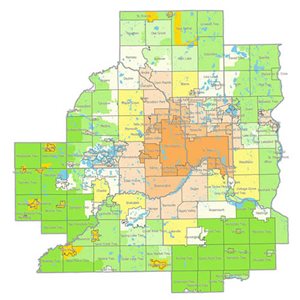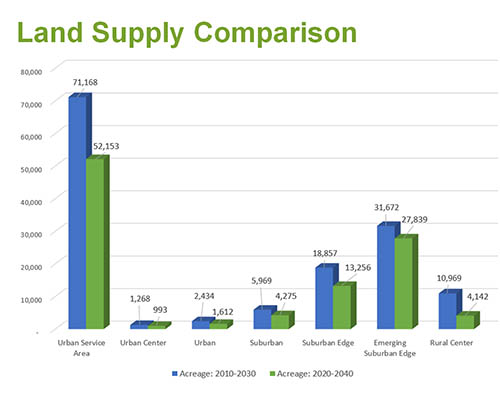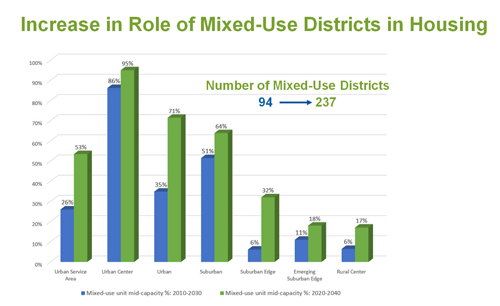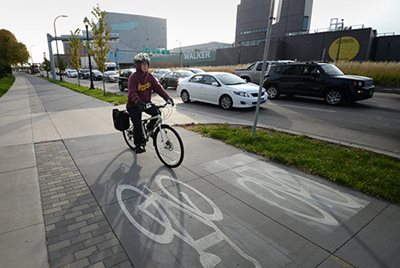 A look at a composite of the 2040 local comprehensive plans submitted to the Met Council shows how local governments in the Twin Cities metro area are planning for shifts in market demand and growth, as well as issues like climate change.
A look at a composite of the 2040 local comprehensive plans submitted to the Met Council shows how local governments in the Twin Cities metro area are planning for shifts in market demand and growth, as well as issues like climate change.
-
Local comprehensive plans support projected growth in the metro area and provide flexibility on where growth may occur. While growth has occurred more slowly than previously forecasted in many cities, some cities have experienced more growth, notably Minneapolis and Edina.
-
Local plans reflect a shift in market demand and increasingly rely on “mixed-use” districts to guide future growth at higher densities than in the past. This trend is occurring at varying degrees in all types of communities. Plans also emphasize affordable housing.
-
City plans emphasize natural resource conservation, environmental sustainability, and addressing the challenges of climate change.
-
Many plans address the need for additional transportation investment, whether roads or transit, and one-third of the plans address the potential implications of connected and autonomous vehicles (CAV or driverless vehicles).
These findings reflect changes in metro area plans from 2030 to 2040. The Council reviews 168 local plans: two from Scott and Carver counties on behalf of 20 townships, a third from a collaborative of 15 small cities and townships in Dakota County, and individual plans from the remaining cities and townships.
As of March 31, 2021, the Council had received 162 plans, though not all are yet complete.
“The plans really are an opportunity for local officials to express their community’s vision for growth and development, and to engage local residents in planning for the places where they live, work, and recreate,” said Community Development Director Lisa Barajas.
“The Council, per state law, reviews local plans to ensure they align with regional plans and policies and are compatible with the plans of neighboring communities,” said Barajas. “But planning is also about the community coming together to chart a path toward a prosperous, equitable, healthy, and attractive place to call ‘home,’ for their families, neighbors, and future generations.”
Council members have spent the last couple of years reviewing the multitude of local plans and have a variety of reactions to the aggregated information.
Watch a presentation about the comp plan composite findings on YouTube.
Council members reflect on comprehensive plan findings
Charlie Zelle, Council Chair
“We hear from some sources that there’s a lack of land available in the metro area to accommodate development. Staff review of the plans, in total, confirm the abundant supply of available land through 2040.
“Land designated as rural in one form or another, whether it’s agricultural or rural housing development at low densities, still accounts for over half of the region’s acreage. I believe the issue for developers is less availability of large, wide-open tracts of land for development in areas served by sanitary sewers.
“My takeaway is that we have significant room for growth and development in the metro area. It’s my hope that we, as a region, will assign the use of that land wisely and thoughtfully, and give careful consideration to land and resources that must be preserved and conserved.”

Council Member Robert Lilligren, Met Council Community Development Committee Chair (and representing a portion of Minneapolis)
“I’m encouraged by the increased commitment to mixed-use development that incorporates a blend of housing, commercial, cultural, public, entertainment, and other uses so they are easily accessible, complement each other, and create a sense of community.
“Mixed land use is occurring in places across the region in what are more typically suburban areas, like Chaska, Shakopee, Lakeville, Inver Grove Heights, Cottage Grove, Woodbury, Plymouth, and Maple Grove. It’s development that uses land efficiently, which saves on infrastructure costs, and that creates vibrancy and a sense of place and belonging.
“When we talk about mixed use, we think of places like 50th and France in Edina, Excelsior, and downtown Stillwater. These development options are popular, engaging, lively, and exemplify attractive and desirable forms of density.”

Council member Judy Johnson, representing northwest Hennepin County
“I’m enthused about the increasing density that comes with mixed-use, but also that mixed-use development is where we can expect more progress on affordable housing.”
Johnson cites an expected increase in residential density, overall, as cities exceed regional density requirements, especially in urban centers, with the highest densities reflected in the Minneapolis 2040 plan.
“There’s no question that the region has a long way to go to produce and provide the amount of housing and affordable housing that will meet regional needs. But I’m encouraged that cities are planning land uses that accommodate housing densities and type, specifically multi-family development, that allow for greater affordability.”

Council member Francisco Gonzalez, representing east metro communities
“Climate change is not a statutorily required element in comprehensive plans, but I’m glad that a good share of communities included planning focused on resilience, energy efficiency, renewable energy, fewer emissions, and vehicle electrification. Science-based stewardship and planning addressing climate issues are key to environmental sustainability and quality of life, and critical to a viable and equitable economy.”
One-third of communities included in their plans a chapter or section on resilience. About 80% cited natural resource preservation in 2040 planning.
“I’m pleased that natural resource conservation is a significant priority in local plans, with a focus on preserving and enhancing tree canopies and tree preservation policies, low-impact and sustainable development practices, and other initiatives to preserve and conserve our shared environmental assets.”
 Council member Deb Barber, Transportation Committee Chair (and representing Scott and Carver counties)
Council member Deb Barber, Transportation Committee Chair (and representing Scott and Carver counties)
“I suspect there will be a lot of enthusiasm for federal investment in transportation infrastructure. It’s not surprising that local plans frequently identify more new and expanded roads than current revenues would likely provide. Transportation has long been underfunded.”
The 2040 plans confirm local commitment to policies and facilities for cyclists. About one-third of the plans address ways to comply with the Americans with Disabilities Act for improved accessibility, and another third address the prospect of autonomous vehicles.
“The federal government has been enormously helpful in efforts to keep transit afloat and transportation projects advancing during the pandemic. But as we continue to open up and experience a new normal, I hope that we, as a state and region, will come together to address the transportation funding issues that have plagued us for decades. It’s past time to dispense with ‘us versus them’ debates that have hindered progress.”
Council Member Wendy Wulff, representing southeast metro communities
“For the past 15 years, the Council has been partnering with cities to inspect and repair wastewater infrastructure. The collaborative effort is working extremely well, saving more than a billion dollars for our customers, because we are able to keep stormwater and groundwater from overwhelming our system. I am pleased to see cities continuing to work hard in their comprehensive planning to continue this important work.”
Wulff cites the work of the Council’s Environmental Services Division as some of the most innovative in the country, with a shout out to collaboration and partnerships in wastewater treatment, water quality monitoring, and water supply planning.
“Between demand reduction strategies, stormwater planning improvements, and a proactive effort to maintain our systems, the region is positioned well to face the future.”
Looking ahead to the 2050 planning cycle
As the work of the 2040 planning cycle winds down, the work on 2050 comprehensive planning begins. Following each decennial census, the regional planning effort starts with adoption of the next Regional Development Guide. The regional plan establishes a regional vision and adopts policies for regional parks, transportation, housing, and water resources.
The policy framework lays the foundation for the next round of local plans due to the Council for review in 2028. The plans of each jurisdiction in the seven counties build upon the regional planning vision. Local comprehensive plans reflect regional policies and identify important local goals and objectives. It’s a collaborative and cooperative approach that strives for both local and regional success and efficiencies.
Council planning authority stems from the Metropolitan Land Planning Act, which tasks the Council with ensuring the orderly and economical development in the seven-county metro.